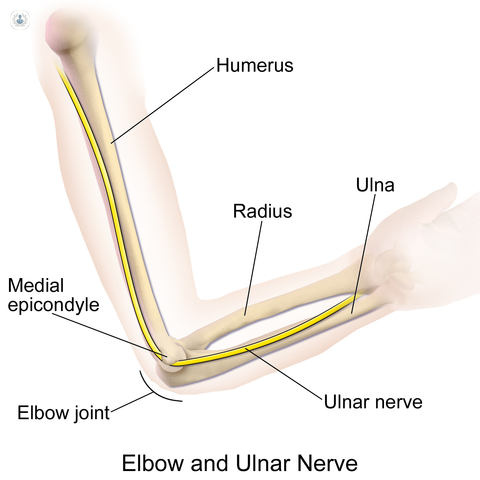Ulnar nerve surgery
Mr Senthooran Raja - Orthopaedic surgery
Created on: 11-13-2012
Updated on: 06-12-2023
Edited by: Carlota Pano
What is ulnar nerve surgery?
Ulnar nerve surgery is a procedure to treat ulnar nerve entrapment, sometimes known as cubital tunnel syndrome. The ulnar nerve is one of the three main nerves in your arm and passes from the neck down into the hand, and is responsible for the area often referred to as the “funny bone”.

The main job of this nerve is to provide sensitivity to the ring finger and little finger while controlling various muscles of the hand. When compression of this nerve happens from nearby tissue, ulnar nerve entrapment syndrome occurs.
Typically, there are two treatment options available. Firstly, non-surgical treatment is given based on physical and occupational therapy, accompanied by medications to relieve pain and reduce inflammation. Secondly, if the previous treatments fail, a specialist will take a surgical approach to relieve the nerve.
Why is surgery done?
Ulnar nerve surgery relieves the ulnar nerve when it’s trapped in its passage through the elbow, and is usually carried out when all other more conservative treatments have failed.
The surgery is mostly performed in order to relieve pain and numbness, prevent permanent nerve damage and improve the overall function of the hand.
What does the surgery involve?
There are two surgical techniques your surgeon may use: open surgery or minimally invasive surgery.
- Endoscopic ulnar nerve release: During this procedure, your surgeon makes up two small incisions in your elbow and inserts an endoscope – a thin instrument fitted with a tiny camera at the end. Your surgeon is then able to divide the ligament compressing the ulnar nerve to give it more space to travel.
- Open ulnar nerve release: During this procedure, your surgeon will make a 3-4 inch incision to the inside of your elbow, allowing the nerve to be viewed and assessed. After inspection, the surgeon usually increases the size of the tunnel which decompresses and frees the nerve.
Preparation for ulnar nerve surgery
A specialist will review the patient's medical history and perform a physical examination and generally, no special preparation is required. There are some tests done beforehand to confirm in what state the nerves are, such as:
- X-ray imaging
- Nerve conduction study (NCS)
Aftercare
The surgery can be done on an outpatient basis, so the patient can leave the same day or spend just one night in the hospital. During the hospital stay, the patient may be given pain relievers.
After surgery, a bandage is applied to cover the wound, then the patient can be subsequently discharged. Full recovery after open surgery usually takes around six months.
Alternative treatments
The alternatives to surgery mainly focus on more conservative treatments, such as physical and occupational therapies that can help strengthen the ligaments and tendons of both the elbow and the hand.
Depending on the severity of the entrapment, the specialist may prescribe non-steroidal painkillers and anti-inflammatories to reduce both inflammation and pain.
If surgery is necessary, the preferred method is minimally invasive surgery, which reduces the size of the incision and the overall recovery time.
